Robyn Spady is an amazing teacher! She’s knowledgeable, organized, friendly, patient, and flexible. Her Extreme Warp Makeover workshop was really great.
Any fears I had about having too much time and not enough warp were completely unfounded. I put on 4-1/2 yards, and got less than 2 woven. I learned LOTS!
I was supposed to weave 30 different patterns on one treadling. I realized after I got home and wet finished that I left one out, so I have only 29. Oh well. Anyway, here they are, in all their glory (not). You’ll notice that you don’t usually see my selvedges – they are BAD. I was focused on trying the various treadlings on a new-to-me loom, not on my selvedges. I also made several treadling errors, some of which are really obvious, some not so much. If I saw the error as I was weaving, I went back and fixed it; the ones that remain I didn’t see during class.
First we did four different lace weaves. As I said, I’d chosen the overshot threading, so I was a surprised we could do any type of lace weave with it. Because the warp & weft were the same color (white), it’s hard to see the detail in the photo.

Next we did waffle fashion. This isn’t a true waffle weave, which requires a specific threading and treadling combo, but rather a treadling that creates some amount of dimension in the weaving. This didn’t work so well on the overshot threading, particularly when combined with the fact that I couldn’t beat very hard on the table loom. This last fact impacted many of the patterns.
Following waffle fashion were 5 different twills. The lace and the twills were the parts that were most familiar to me. Here’s the one sole example of when the lack of a hard beat improved the look – the patterns were more open than the samples Robyn had woven on her floor loom.
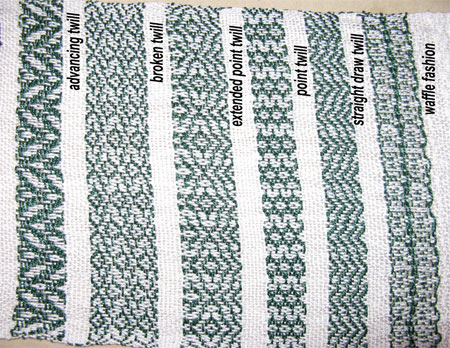
Next came some traditional overshot. I’d never woven any overshot before. In general, I think for me, it may be best used sparingly instead of all over the way the coverlets were. But I may feel differently as I explore it more.
It’s pretty easy to see where I missed two of the picks in the treadling sequence in the star fashion.
After the overshot came shadow fashion. You can see the pattern better if you squint. This is an example of when the lack of a firm beat hurt the visual.
On opposites was interesting. Determine the pattern you want to follow, then insert another pick between each of the pattern picks. In this ‘extra’ pick, raise the two shafts that were up in the first pick. So if in pick 1 I raised 1&2, in pick 2 I raised 3&4.
On opposites polychrome was nice, too – you worked with 2 complementary colors instead of your pattern color and warp color.
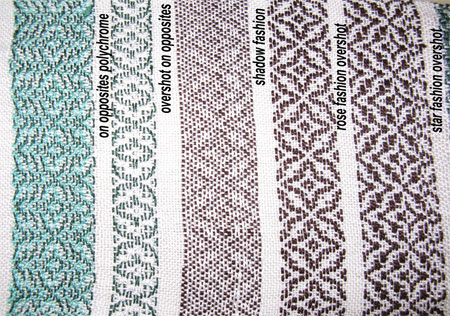
Next up was monk’s belt. I’ve never been fond of this pattern visually, and found I didn’t like weaving it much, either, so I wove only half of the treadlings and moved on.
Before the class, I would have told you that I wouldn’t have liked weaving that looked like fine needlework. And I would have been wrong yet again. I do. I like weaving it, and I like the way it looks. I liked the cleanliness of the swivel and petit-point better than the polychrome. This is where I inadvertently skipped a sample. I was supposed to weave the swivel with the colors switched – white where it had been dark and vice versa. It does give a different, complementary pattern.
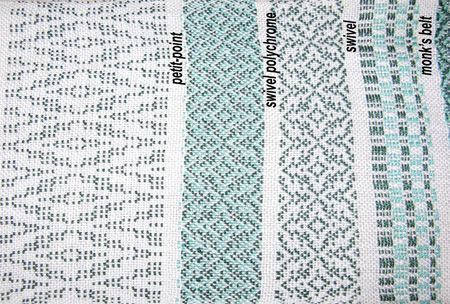
Next up was crackle fashion. Again, not a true crackle weave, but an imitation of one. Crackle weave is supposed to remind the viewer of pottery with crackle finishes. I don’t much care for that pottery, or that weave pattern.
Then came the summer and winter fashion weaves. (Nope, not true summer & winter.) Again a surprise for me. I didn’t think I’d like the dukagang (a Swedish structure), but I do.
The double faced weave was quite interesting. (It’s quite different from doubleweave.) You can see that it’s the same pattern, dark brown on one side and light blue on the other. It takes a long time to weave, and the finished fabric is quite thick.
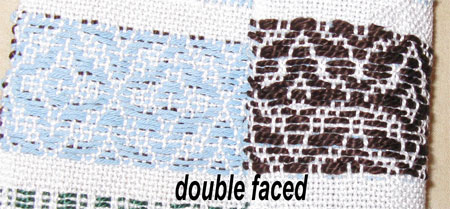
A ribbed weave was next. I made several treadling errors, so mine didn’t rib the way it should have. I’ll admit it – I saw before I was done with the sample that I’d made errors, but I didn’t have the energy to unweave and reweave.
Now was the corduroy. This really didn’t work well with the lack of firm beat of the table loom. I did cut a few of the rows of cords, but I’m positive it will all pull out easily, so I stopped. So don’t take my example as a good one. It’s really an amazingly impressive technique.
I used three strands of heavier yarn together for the deflected weave, which worked quite well.
We finished our selection with the echo fashion. When beat more firmly, it appears that there’s a glow around the darker pattern.
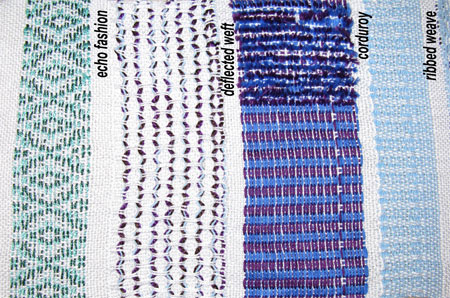
I learned other things, too, that I didn’t have time to weave over the weekend. They’re for some future post.

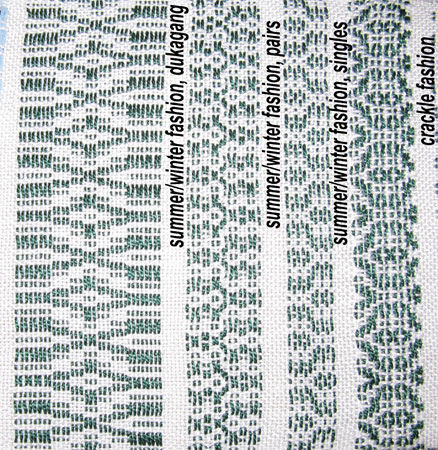

[…] Weaving a Gem of a Life, MAFA Weaving Sample […]
[…] decided this was a great opportunity to try something I’d been wanting to do since the MAFA workshop in July – name drafting in overshot. Since I was only making a scarf and wanted to […]
[…] when I was at MAFA I bought a bunch of yarn from vendors there. Obviously I liked it all or I wouldn’t have made […]
These are lovely patterns. The double faced, and petit-point! I love it!
Wowee – Your brain must be swimming by now!! I rally liked the waffle fashion. What a productive weekend you had!
I saw Dr. Kim today – she asked after you as in how did our show go – she is always interested.
Talk later!
A